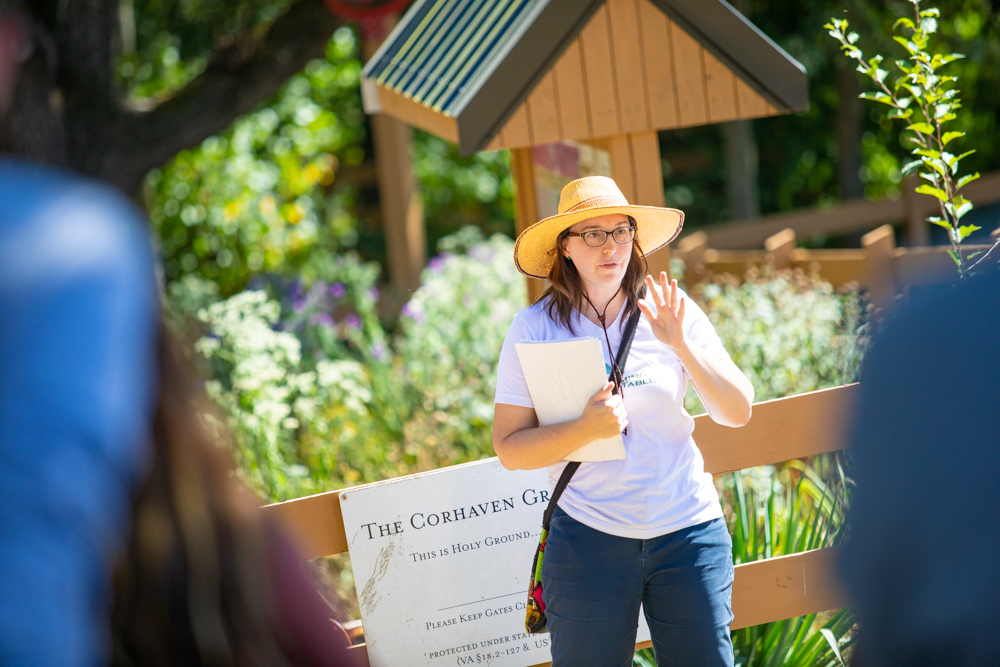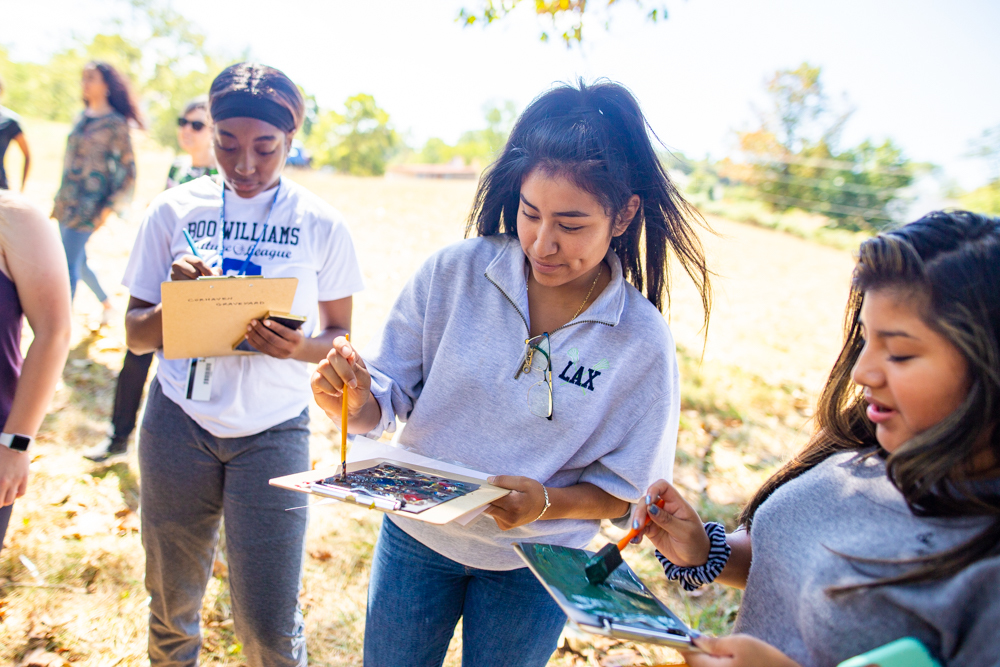On a sunny day in September, 64 students from Eastern Mennonite University stood in a graveyard, listening to the names of people who may be buried there. Cream violets blanketed the ground, likely planted on the graves by mourners from another age. Graveyard director Sarah Kohrs rang a bell, its somber tone signifying a time for silent reflection.
No one knows for sure who is buried in this clearing by a wooded stream, half an hour from EMU’s campus, because they were enslaved Virginians – African Americans who died on a plantation outside of present-day Quicksburg, Va. Many of the graves have no marker at all, and the ones that do are simply bare stones.
Jakya Jones visited the graveyard on the September field trip. Being African American herself, Jones said the field trip held deep personal significance – “a sea of emotions.”
“I don’t know where I’m from. I don’t know where my ancestors were from. I just know that my immediate family is from Virginia … so these could potentially be my relatives, is how I walked into it,” Jones said. “That’s probably why I got so emotional. I attached myself to them because, if I was born in another time, I could have been them.”
The graveyard is called Corhaven and is part of the Christian spiritual retreat Coracle. The name Corhaven is a combination of the Latin word for heart and “haven,” in the sense of a “resting place for weary travelers.”

Connecting classroom readings to the real world
About half of the 64 students on the field trip are taking a senior seminar with professors Marti Eads and James Richardson, titled “Stairway to Heaven: Music, Literature, and Meaning.” The rest are in Eads’ class on global literature, which includes works by Phillis Wheatley, Olaudah Equiano, and Thomas Jefferson.
Keith Bell visited the graveyard with the global literature class, and said that the trip allowed him to understand Equiano’s memoir on a deeper level. The book is “the first recorded slave narrative,” Bell explained. “It was a lot easier to immerse yourself in the text, and to truly see what standpoint he was coming from.”
And to confront this horrific history only 20 miles away from campus – “how close to home it feels … was very eye-opening,” Bell said.
Senior seminars are team-taught courses that encourage students to reflect on their own identities, voices, and life journeys. The courses are interdisciplinary by nature: Eads teaches in the language and literature department; Richardson, in music.
Eads said that she and Richardson wanted to teach this seminar “because we share a commitment to helping orient students toward the Kingdom of God as well as profound admiration for Ron Rash’s exploration of that orientation process in his novel The World Made Straight.”
[Eads spent her 2015-16 sabbatical exploring Rash’s novel and more broadly, the theme of trauma in literature: she participated in a Strategies for Trauma Awareness and Resilience training at EMU and attended a Council of Independent Colleges American history seminar summer seminar on slave narratives at Yale University before embarking on her study. Read more about her studies.]
Their students read The World Made Straight before the Corhaven visit. Eads explained that the book grapples with community-wide trauma. In that context, “we wanted to take our class to a site that would be rich in meaning,” she said.

Acknowledging the history in ‘our backyard‘
Kohrs hopes that visitors leave Corhaven recognizing that slavery happened here, “in our backyard.” At one time, she said, 12 percent of the population of Shenandoah County was enslaved.
“I hope that in coming there, they recognize it’s not about shame or blame, but it’s about understanding the past, so that we have a better understanding of the present,” Kohrs said.
Bell said the field trip was that eye-opening experience for him. He grew up in Staunton, and attended a rural high school that did not teach about slavery in any depth.
“Being Caucasian from a primarily Caucasian area, you don’t really learn much about slavery … [Corhaven] helped me to acknowledge it more,” Bell said, “realizing where we are, the history that we have with slavery, and also incorporating that into understanding our text in class.”
Kohrs has continued efforts begun by the history club at nearby Stonewall Jackson High School to identify those buried, by combing through plantation documents, circuit court records, and whatever other 19th-century paperwork wasn’t burned during the Civil War. She started out as a volunteer at the site in 2015, restoring the cemetery to “create a sacred space that could be dedicated to the public,” Kohrs said. The restoration was finished in 2016.
Nobody is certain exactly how many people are buried at Corhaven, or where. Because of this, Jones said she was careful where she walked, to show respect.
Kohrs said it’s “essentially a life-long project, trying to know the families and the names that are connected there.” Her background is in archaeology, and while she doesn’t conduct any “invasive” research that would disrupt the graves, Kohrs does use those skills as they apply to research.

Corhaven as an emotional experience
Elena Bernardi, a peacebuilding and development major, also went on the field trip. As an Ethiopian-Italian woman who recently moved to the U.S., she approached the experience with a more analytical bent, making connections between Corhaven’s history and The World Made Straight.
“However, when we went inside the actual cemetery and saw the ‘scattered’ placements of the graves, it quickly turned into a deeply human and emotional moment, academics aside,” Bernardi said. “The unmarked graves and missing identities and names created a haunting feeling, more tangible than the one in the book.”
The fact many of those buried at Corhaven were not given so much as a stone marker affected Jones, as well.
“The disrespect in that … that was hard,” Jones said. “When I go visit my grandma or someone, I visit a tombstone.”
“Although this legacy is incredibly painful,” Eads said, “Sarah [Kohrs] invites others into the space to reflect, mourn, and honor the individuals buried there.”
Kohrs splits her time between physically caring for the cemetery and leading tour groups of local students, scout troops, book clubs, and other community groups. She’s hosted everyone from the Sons of Confederate Veterans to Coming to the Table, a national organization with roots at EMU that brings together descendants of the enslaved with the descendants of slave owners. Master gardeners volunteer regularly to do most of the physical upkeep, and include community volunteers in their work.
It’s an “opportunity to do a lot of reconciliation work,” around slavery, Kohrs said. “A tangible way to really come into contact with that aspect of healing.”
The students ended their trip with time to write poetic reflections. Bernardi shared an excerpt: “The depressions on the ground, the unevenness of the landscape, created a somewhat eerie feeling; if it weren’t for those details, the place could have been overlooked or mistaken for something with no past or human history.”
To learn more about visiting the Corhaven Graveyard or volunteering community work days, contact Sarah Kohrs at 434-922-2029 or email corhavengraveyard@inthecoracle.org.
